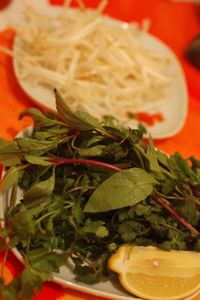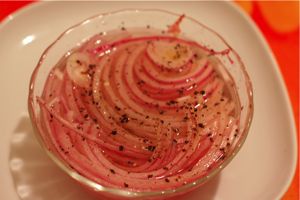Pho ga is an excellent way to prepare meals ahead of time. My mom used to simmer the chicken on Sunday, boil a big batch of noodles, wash all the herbs, and then refrigerate the components separately. It only takes about 10 minutes to reheat the stock and noodles for a comforting bowl of soup anytime during the week.
Eating my way through my husband's very first pot of pho ga brought me back to the land of the living. Here, verbatim, is the recipe:
Half-Conscious Notes on Making Pho Ga
Preparation
1. Cut chicken in half & pull off fatty chunks @ tail
2. Cover with cold water. Add onion (halved), some carrot logs, lots of star anise (8-10) a few cloves, teaspoon of peppercorns, and cinnamon stick. And Bay Leaf for the French. Add giblets, etc. & fennel seeds.
3. Bring just [double underlined] to a boil, then lower heat, cover partially & simmer gently 1 1/2 hour.
4. Remove chicken. remove big chunks of meat & return carcass. continue simmer 2-3 hrs.

Shopping List and Additional Notes
Ingredients
One 4-5 pound chicken
1 package wide rice noodles
A small hand of ginger
1 large onion
1 small carrot
Spices: star anise, cinnamon stick (preferably Vietnamese cassia), peppercorns, cloves, fennel seed
Fish sauce
Fried shallots
Fresh herbs: scallions, cilantro, Thai basil, saw-leaf herb, Bay leaf (optional)
Mung bean sprouts
Lime wedges
Fresh Thai chiles
This is the dream list for a homemade bowl of pho ga. Decent shortcuts include using good-quality, prepared stock and the meat of a rotisserie chicken. If you keep a box of premixed spice packets in your pantry (they look like big teabags), you can infuse plain chicken stock with Vietnamese flavors in 20 minutes. I've been known to enjoy a bowl of pho with only scallions for garnish, but each additional herb really does make a huge difference.
When buying rice noodles for this soup, look for the words banh pho ga on the label. If you're lucky enough to find fresh ones, you'll just need to immerse them for 10 or 15 seconds in very hot water. Dried noodles require 2 to 3 minutes of boiling.
I have a wide, extremely sharp cleaver that eases right through chicken bones. Halving chickens is also super simple if you have good kitchen shears. If you don't have a pair...get some. One of the must useful tools ever. Look for the heavy-duty ones with a round indentation at the base of the blades; that's what allows you to snip through the ribs and along the backbone. For those who think this all too much, just go ahead and buy chicken parts (bone-in!), but be sure to simmer the meat for only 30 or 40 minutes before stripping it off the bones. Having exposed bone marrow extracts more flavor. Besides, anyone who's tried to remove a whole chicken from a pot of simmering water can vouch for the wisdom of chicken halves or parts.
If you can, throw in a few extra chicken wings or, best of all, a couple of feet.
My family never bothered to strain the soup. All the aromatics and bones sink to the bottom of the pot, and we'd just ladle the soup from the top. If you prefer, though, you can strain the stock and reheat.
Vinegared onions are a favorite topping that's rarely available in restaurants. To make your own:
1. Slice an onion very thinly.
2. Drizzle generously with white vinegar.
3. Stir in lots of coarsely ground black pepper.
4. Let stand for 10 minutes and then serve alongside the herb platter.
Arrange sprigs of the fresh herbs, lime wedges, bean sprouts and chiles on large platters for finishing the soup at the table. Set a big bottle of fish sauce right on the table, too, because this is a Vietnamese meal, after all.
I like to pour boiling water (from cooking the noodles) over the bean sprouts to blanch them so they aren't hard and cold in the soup. (Shhhh, don't tell my Saigon-born mom. That's a Northern trick that I adopted after leaving home.)
For each diner, place a small nest of noodles in a large, preheated bowl. Cover with very hot stock and add a handful of shredded chicken. Sprinkle with chopped scallions, chopped cilantro and fried shallots. Let guests fine-tune their bowls with herbs and other flavorings as desired.



